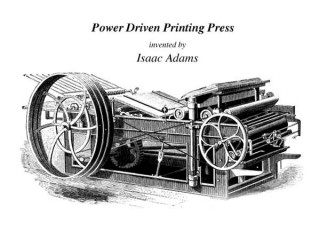
Isaak Adams Jr. biography
Date of birth : 1836-02-20
Date of death : 1911-07-24
Birthplace : South Boston, U.S.
Nationality : American
Category : Science and Technology
Last modified : 2010-04-21
Credited as : American discoverer, promoter of electrochemical nickel-plating process,
1 votes so far
Isaac Adams, Jr.’s mother died when he was only a few years old. He was educated at Sandwich Academy (1846-48). Chauncey Hall School (1848-54), Bowdoin College (1854-58), Harvard Medical School (M.D., 1862), and Ecole de MEdicine in Paris (1862-64). In late 1864 he established himself as a physician in Boston, but attracted to industrial chemistry, he served also as an analytical and consulting chemist for the next few years to his Uncle Seth’s Adams Sugar Refinery, to a glass manufacturing business, and to other businesses.
In his testimony in a nickel-plating patent suit against Edward Weston in 1874 Adams stated that he had been succesful in producing a nickel electrotype while studying under Josiah Parsons Cooke at Harvard from 1858 to 1860. He was unable to repeat this feat in the winter 1865-66 while engaged in nickel plating over 100 gross of gas burner tips.
Faced with this inconsistency in 1866, he investigated the effect of such impurities as zinc, arsenic, copper and iron on the electrodeposition of nickel. He found that nickel deposited best in neutral or slightly acid solutions, in the range between neutral litmus and congo red paper. Adams also found that cast nickel anodes could be produced which dissolved satisfactorily to maintain the solutions during plating.
Armed with this knowledge, Adams decided in 1868 to devote himself wholly to the commercial introduction of nickel-plating even over his father’s objections. He obtained a number of patents in 1869 and early in the year took over the nickel plating business of Wm. H. Remington and Co. of Boston. When the company failed, he formed from it the Boston Nickel Plating Co., which operated for about 100 years.
A United Nickel Co. was also incorporated in New York June 14, 1869, with Adams as president. This company owned the patents and after they expired, went out of business in 1890, having filed hundreds of patent suits and collected royalties from more than 1000 licensees. In the latter part of 1869 and the first half of 1870, Adams went to Europe and visited England, France, and Germany to introduce commercial nickel plating. He was partcularly succesful in England and France.
Scheme of the electrochemical plating of nickel
A typical electroplating cell consists of anode, cathode, aqueous-metal solution, and a power supply. In the simplified example shown here, the sacrificial anode is made of nickel, the cathode is made of another conductive material, and the aqueous-metal solution consists of nickel (Ni2+), hydrogen (H+), and sulfate ions (SO42-). When the power supply is turned on, the positive ions in the solution are attracted to the negatively biased cathode. The nickel ions that reach the cathode gain electrons and are deposited or plated onto the surface of the cathode forming the electrodeposit.
Simultaneously, nickel is electrochemically etched from the nickel anode, to produce ions for the aqueous solution and electrons for the power supply. Hydrogen ions that also gain electrons from the cathode form bubbles of hydrogen gas. The formation of hydrogen gas is undesirable since it lowers the plating efficiency (i.e., only a fraction of the total current is used to form the electrodeposit) and the bubbles can obstruct the deposition of the intended electrodeposit.
Adams also became an expert glass blower and made a large number of Geissler tubes which he sold between 1865 and 1868. In 1865 he developed a vacuum tube carbon “burner” incandescent electric light, about 14 years prior to the Edison-Swann inventions of 1879. Early in 1867 he went to Europe, partly to consider the commercial possibilities of electric lighting with A. Gaiffe of Paris, an instrument maker who later became his French backer for the sale of nickel plating. At this time electricity was largely of battery origin, and while Adams’ introduction of dynamo electric machines, in 1867 he decided not to enter the electric light business for lack of a cheap source of electric power.
A U.S. breech-loading rifle made in 1865
Adams also made other discoveries of importance from time to time. An historian of Bowdoin College stated that his work on breech-loading rifles was hardly less important than his invention of nickel-plating. He became widely known as an outstanding electrochemical expert and teamed up with Charles F. Chandler of Columbia University in connection with the nickel-plating suits. Some work for Hood Rubber Co. resulted in a patent on the use of copper plate on steel shafts for bonding rubber to the steel for clothes wringer rolls.
Adams married Lucille Emille Lods in 1869 or 1870. She was in some way related to his French backer, A. Gaiffe, and had two daughters by previous marriage. Adams had two sons, Walter Owen (1877-1926) and Rayne (1880-1931), but no further descendants.
Stock certificate of the Adams’ Company
Following the succesful putcome of his nickel-plating patent suits in the period from 1871 to 1886, Adams largely retired from public life. He had a special interest in the variations of the magnetic field of the earth and reported his measurements to the U.S. Geodetic Survey.
He died at Annisquam, Mass., July 24, 1911.
















